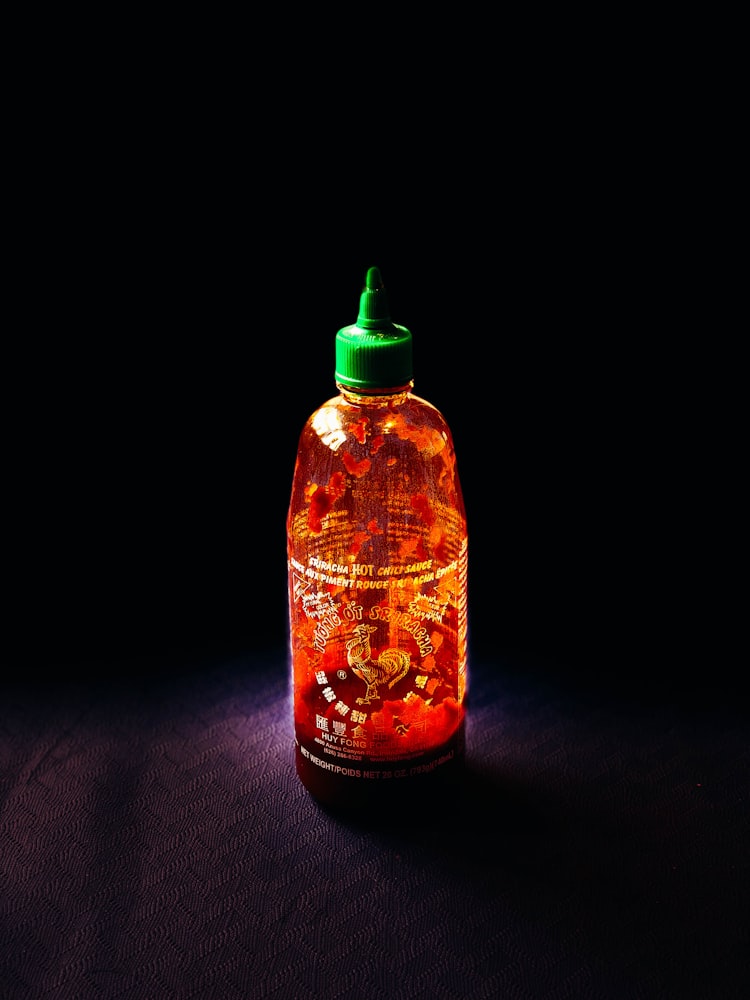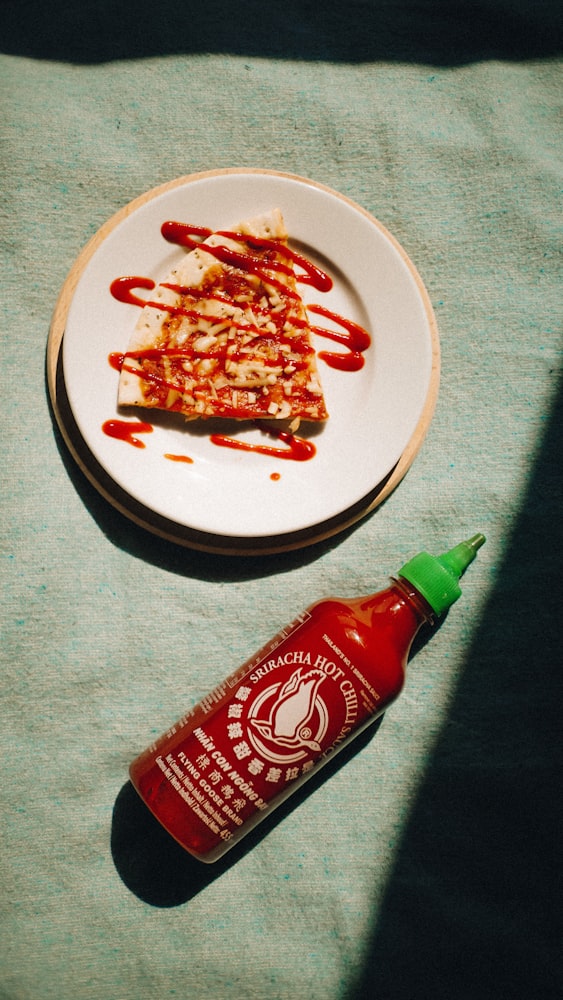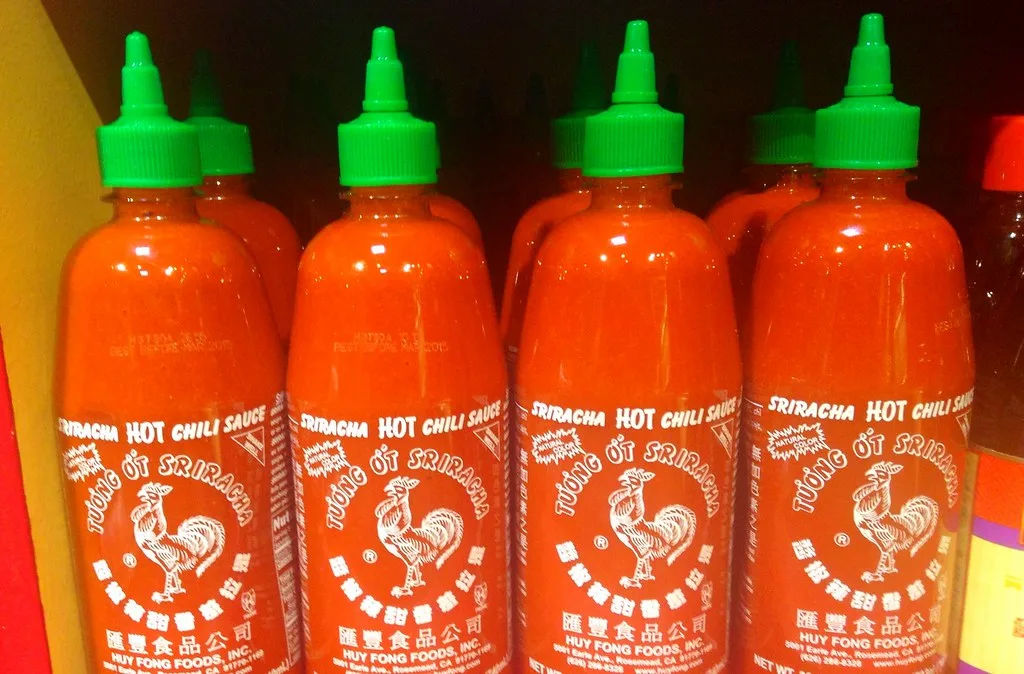In a Nutshell:
- Shelf life: 2-3+ years unopened, at least 6-9 months opened
- Spoilage signs: off smell, mold, or texture change
- Storage methods: cool, dry place for unopened bottles; refrigeration for opened bottles optional
Hey there, fellow Sriracha fanatics! We all know that a little drizzle of this fiery red sauce can take any dish from “meh” to “WOW!” in a heartbeat. But have you ever wondered how long your beloved sriracha sauce can last, how to store it, and when to say goodbye to that half-empty bottle?
Well, I’m here to spill the (Sriracha) tea!
In this article, we’ll dive into the shelf life of Sriracha, courtesy of our friends at Huy Fong Foods, explore the telltale signs of spoilage (so you can avoid the dreaded sriracha go-off), and share some handy storage tips to keep the condiment fresher for longer.
You won’t want to miss this spicy scoop, so stick around!
Sriracha is sometimes called rooster sauce. That’s because of the image of a rooster on the label of the most known Sriracha brand: Huy Fong Foods.

Table of Contents
- How Long Does Sriracha Last?
- What Affects Sriracha Shelf Life?
- How to Tell If Sriracha Is Bad?
- Changes That Are Actually Okay
- Does Sriracha Need to Be Refrigerated?
- How to Store Sriracha
How Long Does Sriracha Last?
An unopened bottle of Sriracha sauce easily lasts a couple of years beyond the printed date. After opening, Sriracha typically retains best quality for at least 6 to 9 months but will stay safe to eat (and quite spicy) for months more.
That’s the scoop. But let’s dive a little deeper into this flavorful world, shall we?
Unopened Sriracha: A Long and Flavorful Life
When it comes to unopened Sriracha, you can expect it to last at least a few years past the date printed on the label.
That’s right; this versatile sauce has some serious staying power. Like other hot sauces, soy sauce, and Worcestershire sauce, unopened Sriracha boasts a lengthy shelf life that puts other condiments to shame.
Now, what about the expiration date printed on the bottle?
It’s not an expiration date but a best-by date that’s only a rough estimate of when your Sriracha will start losing its spicy kick. Going past it doesn’t mean your Sriracha is expired or bad.
The worst that’s likely to happen is that you’ll notice a slight change in flavor.

Opened Sriracha: No Hard and Fast Rule
After opening, Sriracha sauce tastes best for 6 to 9 months if you store it in a cool and dark place, and more than a year longer if you refrigerate it.
That said, the hot sauce is unlikely to spoil in the usual meaning of the word for months longer. What’s more likely to happen is that, at some point down the road, you’ll notice that it’s not good enough for your liking. That’s when you toss it.
(We’ll cover spoilage signs below, so hang tight.)
In other words, there’s no hard and fast rule. It all depends on how well you store it and how often you use it.
Compared to other condiments, Sriracha has a shelf life similar to that of Tabasco sauce and infinite times longer than a mild sauce: salsa.
Now, let’s talk about what makes the shelf life of this hot sauce so long.
What Affects Sriracha Shelf Life?
Sriracha’s main ingredient, chili peppers, contain natural preservatives like capsaicin, which helps keep the sauce fresh for longer. The vinegar in Sriracha also acts as a natural preservative, warding off bacteria and extending the shelf life.
So, the magic combination of chili peppers and vinegar gives Sriracha a one-up on other condiments in the staying fresh game.
Now that we’ve covered the shelf life of Sriracha, it’s time to talk about spoilage signs. Stay tuned to learn how to identify expired sriracha sauce and keep your taste buds safe!

How to Tell If Sriracha Is Bad?
To tell if Sriracha has gone bad, look for changes in its appearance, smell, and taste. These may include mold growth, a fermented odor, a change in texture, or an off-taste.
Now, let’s dive into the signs in more detail, and then we’ll discuss some changes that may be concerning but are actually okay.
Mold Growth
The most obvious sign of spoiled Sriracha is the presence of mold spores. If you notice any fuzzy or discolored patches on the surface or inside the bottle, it’s best to toss it out to avoid the risk of food poisoning.
This rule also applies to pretty much all other condiments, including fish sauce and cocktail sauce.
Fermented Odor
A strong, foul or fermented odor can be another indication that your Sriracha has gone bad.
If it smells off or has a distinctly sour or pungent aroma, it’s likely that bacterial growth has occurred, making it unsafe to consume.
Change in Texture
If your Sriracha has become super thick, lumpy, or completely separated, it’s a sign that the sauce has spoiled. Fresh Sriracha should have a smooth, pourable consistency.
Off Taste
Finally, an off or rancid taste is a clear sign that your Sriracha has gone bad.
If you’re unsure about its quality, give it a small taste test. If it tastes strange or unpleasant, it’s time to replace it. This is also a good practice for checking the freshness of Gochujang, anchovy paste, and other flavorful sauces.
Now that we’ve covered the signs of spoilage let’s discuss some changes in Sriracha that might be concerning but are actually okay.

Changes That Are Actually Okay
Darkening Color and Oxidation
Sriracha can naturally darken over time due to the oxidation process. A darker shade of red doesn’t necessarily mean the sauce has spoiled, but rather that it’s been exposed to air. While this may affect the flavor slightly, it’s still safe to consume.
This is also true for some other condiments like BBQ sauce and Hoisin sauce.
Thickening Consistency
As Sriracha ages, it may thicken slightly. This is normal and doesn’t necessarily mean it’s gone bad. Give it a good shake to redistribute the ingredients, and it should be good to go.
This also applies to mustard and horseradish sauce.
Now you know the difference between Sriracha that’s gone bad and changes that are actually okay.
Let’s finish off with storage practices.
Does Sriracha Need to Be Refrigerated?
Once you’ve opened a Sriracha bottle, it’s a good idea to refrigerate Sriracha. While it may not spoil easily at room temperature, refrigeration helps preserve its flavor, color, and texture, ensuring that it stays fresh and delicious for longer.
That means refrigeration isn’t a necessity, but if you’re going to need more than a couple of months to use up the leftover sauce, placing that bottle of Sriracha in the fridge will help.
As I already mentioned, leaving a half-open bottle at room temperature is okay, too, just like it is for most hot sauces out there. Sriracha’s natural preservatives help prevent bacterial growth, making the chili sauce safe to eat even if not refrigerated.
The same goes for other sauces like Teriyaki sauce and oyster sauce, which also benefit from refrigeration after opening.
Now that we know whether Sriracha needs to be refrigerated, let’s dive into proper storage practices for the dipping sauce.

How to Store Sriracha
To keep your Sriracha at its best, follow these simple storage tips:
Keep It Airtight
Always tighten the cap on your sriracha bottle after each use. This helps prevent oxidation, which can lead to a change in flavor, color, and texture. It also minimizes the risk of contamination from airborne bacteria or mold spores.
Store Away From Heat and Light
Sriracha and other condiments should be stored away from direct sunlight and heat sources. High temperatures and light exposure can cause the sauces to degrade, affecting their flavor and appearance.
Find a cool, dark spot in your pantry or cupboard for unopened bottles, and reserve a space in the refrigerator for opened ones if you need them to retain quality for 6+ months.